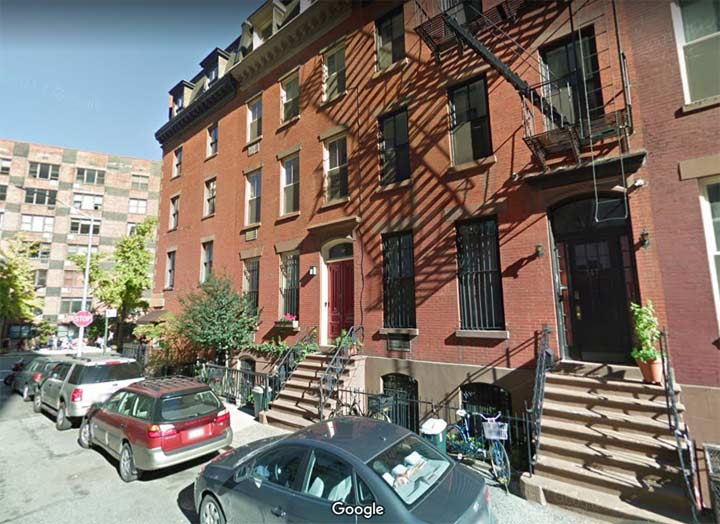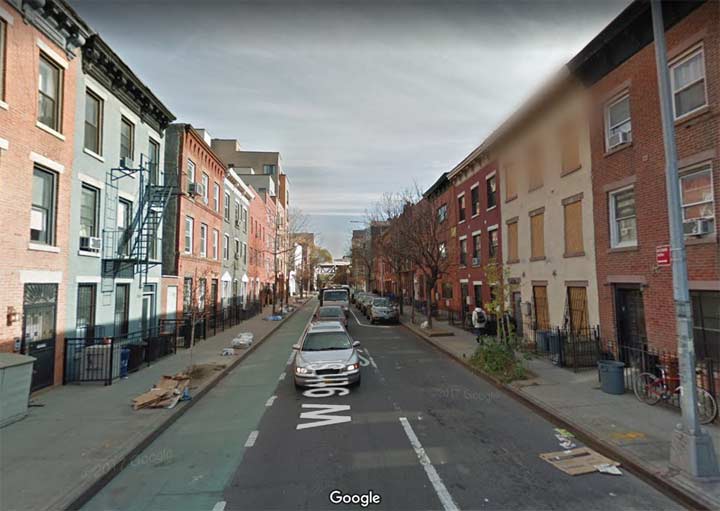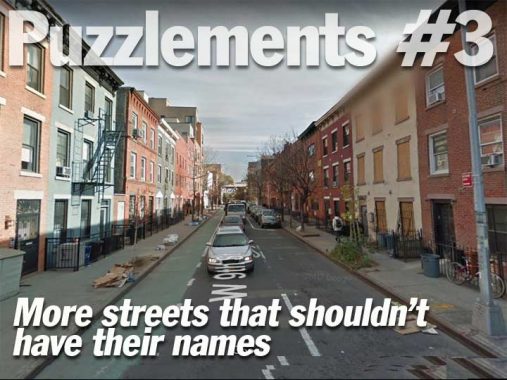Time for another entry in Puzzlements, Forgotten New York’s examination of noncontextual street names, especially named streets smack in the middle of areas featuring numbered or lettered streets, or even lettered or numbered streets smack in the middle of a group of named streets, such as Port Richmond’s Avenue B (seen on this page) or B Street in Pelham Bay, Bronx.
To save time preparing this piece, I’ll use images captured from Google Street View.

West 4th Street at West 13th Street
West 4th Street
For much of its route 4th Street in Greenwich Village behaves as though it were part of the overall street grid mapped out by John Randel in the early 19th Century, especially east of the Bowery, where it joins its parallel brothers East 3rd and East 5th Streets. However, the west Greenwich Village street patter is a bit wonky, with streets eventually settling on more of a SW-NE orientation rather than a bit off from east-west, like the rest of Manhattan Island. And, south of Washington Square, there are just two numbered streets west of Broadway, West 3rd and West 4th. The grid begins in earnest with 8th Street, where 5th Avenue becomes the east-west divider.
After ceding its name temporarily to Washington Square South, West 4th pushes west to 6th Avenue/Avenue of the Americas. But then something strange happens. It turns northwest, and keeps going and going. Because West 10th, 11th, 12th and 13th turn southwest and keep going themselves amid a thicket of named Greenwich Village streets, West 4th actually intersects them and seems to disprove the notion that parallel lines don’t meet.
This situation arose because West 4th, 10th, 11th, 12th and 13th all once carried names (as shown on this page) and at one time, their intersections posed no headscratching from out of towners.
In the very early 1800s, West 4th Street was originally named for the nearby Orphan Asylum Society which stood on Asylum Street between Bank Street and Troy Street (now West 12th St.)
The asylum was demolished in 1833, and soon after, the street was renamed as West 4th Street. Only later were the other streets, Amos, Hammond, and Troy, respectively, renamed West 10, 11 and 12 Sts.

West 9th Street, Red Hook
Brooklyn has a few duplicate streets, such as Atlantic Avenue (Cobble Hill, Fort Greene, etc., and Sea Gate) and West Street (Gravesend, Greenpoint). It also has two West 9th Streets. One of them can be found in Gravesend, and runs in one piece from Bay Parkway south to 86th Street and Avenue V. (I always thought it strange that 86th Street pushes so far southeast into Gravesend, but this 1873 map shows that it was always mapped to do so.)
The other West 9th Street is on the outskirts of Red Hook at the south end of Carroll Gardens and is a literal western extension of 9th Street, running from Smith Street west to Columbia Street. Maps made before about 1900 show it as Church Street.
The first 9th Street bridge crossing the Gowanus Canal was completed in 1905; in 1999, the bridge reopened after a complete renovation. In the 1930s, a massive railroad trestle carrying the IND subway was built over it. My educated guess why Church Street became West 9th is that the city wished to continue 9th Street further west after the bridge opened in 1905, but didn’t want to renumber all the houses on the street all the way to Prospect Park, which they’d have to do. So, West 9th Street it was.
18th Avenue and East 4th Street, Kensington
18th Avenue, Kensington
Most of Brooklyn’s numbered avenues in Bensonhurst and Borough Park (originally parts of the Town of New Utrecht) come to a screeching halt at Dahill Road and are prohibited from attaining the Promised Lands of Kensington and Parkville (originally parts of the Town of Flatbush). In this subtle way, the old lines of these formerly politically divided rival towns are preserved. Each has its own street naming system, New Utrecht’s a mix of numbered Avenues and Streets, while Flatbush is a bit more complex, with east-west lettered avenues and north-south numbered streets. However, there are two sets of numbered streets in Flatbush, a set of West and East streets, with McDonald Avenue or West Street serving as the dividing line.
18th Avenue serves as the Town of New Utrecht’s Vasco Núñez de Balboa, ranging further east than its brother numbered avenues, getting as far as Coney Island Avenue before changing its name to Ditmas Avenue.
This 1890 map shows 18th Avenue in Parkville, an early 19th Century small town absorbed by Flatbush, as Franklin Avenue. Unfortunately when the City of Brooklyn annexed territories such as the town of Flatbush, it wound up with a number of duplicate names, and, unlike Boston, NYC has always seemed to dislike such duplicates in one borough, which Brooklyn became after it joined Greater New York. What to do?
Ditmas Avenue was extended west but at a different angle. Thus, Franklin Avenue became a northeast extension of 18th Avenue, which ever since has pushed further into Flatbush than any other of Brooklyn’s numbered avenues.
Oceania Street at Horace Harding Expressway (LIE)
Oceania Street, Bayside
There are a number of head-scratchers in Bayside, where some named Streets appear in thickets of numbered Streets. One is Oceania Street which runs from Northern Boulevard south to beyond the LIE, where it merges with 210th Street. It slots in between 208th and 210th, and so, to be Captain Obvious, it takes the place of 209th. Why Oceania? The street is nowhere near any bodies of water at all. Perhaps one of the companies developing the area in the early 20th Century was called Oceania; today, the name is a political term for the southwest Pacific including Australia and the islands comprising Indonesia and Polynesia.
Interestingly Oceania Street was never numbered. This 1922 Hagstrom map shows mapped streets that had not yet been built, and Oceania Street is called Lonesdale Avenue.
A puzzlement, indeed.
Corporal Kennedy Street at 41st Avenue
Corporal Kennedy Street, Bayside
A pair of Bayside streets are named for military men, both corporals. Corporal Kennedy, a busy, 2 lane route, begins at Northern Boulevard a little east of Oceania Street and runs north into Bay Terrace, where it becomes 18th Avenue. It slots in between 209th and 210th, and so, has never had a name.
Turning to the 1922 Hagstrom again, it was mapped back then as Gardiner Street. Tis a puzzlement to me that the number was completely skipped here and a named street inserted between two consecutive numbers. The same thing happens with Bell Boulevard, between 213th and 214th, but to me that’s more understandable.
Cpl. Kennedy Street was named long before the current practice of applying street sobriquets by listing the entire name on a separate sign, and I’ve always been curious about these mysterious military men. The Parks Department has supplied information on Corporal William Kennedy because a playground at Corporal Kennedy Street and 33rd Avenue was also named for him:
Corporal William F. Kennedy (1893-1918) [was] an army mechanic killed in action during World War I (1914-1918). Kennedy was born and raised in Bayside, where his father was a police officer. After the war broke out, he joined the army, and began training at Fort Upton, the present site of the Brookhaven National Laboratory on Long Island. He was then stationed in France, where he served as a mechanic with the 107th Infantry Regiment, 27th Infantry Division. On September 30, 1918, Corporal Kennedy was killed while out on maneuvers. He is buried in the Somme American Cemetery in Bony, France.
World War I took the lives of over 8.5 million people, including 57,476 Americans – 13,956 New York State residents and 7,455 inhabitants of New York City. Monuments to those who lost their lives are located throughout the city, and several roadways and parks are named in their honor. Corporal Kennedy Street is a stretch of roadway from Little Neck Avenue to Northern Boulevard on which Kennedy once lived. The roadway, formerly Gardiner Street, was renamed by a local law on April 21, 1925.
Corporal Stone Street at 36th Avenue
Corporal Stone Street
This shorter street is a somewhat more straightforward renaming, as it simply takes the place of 214th Street between 35th and 40th Avenues.
Forgotten Fan Hugh Walcott:
Why this distinguished pair do not have their full names on their street signs is something that should be taken up with the Department of Transportation, dontcha think?
Check out the ForgottenBook, take a look at the gift shop, and as always, “comment…as you see fit.”
11/7/17
